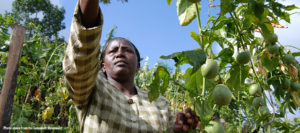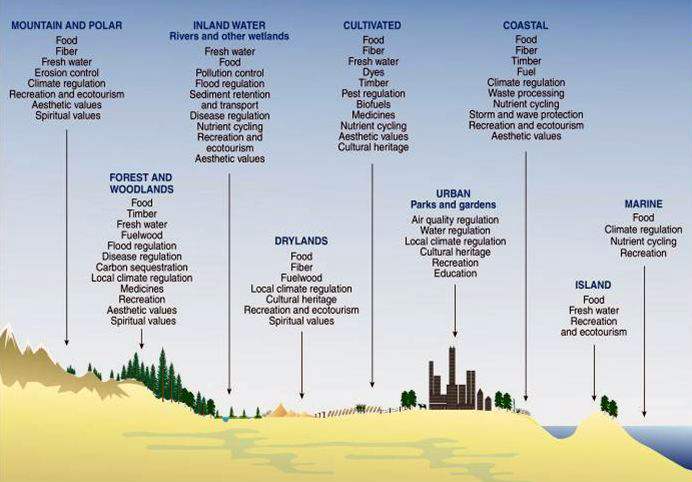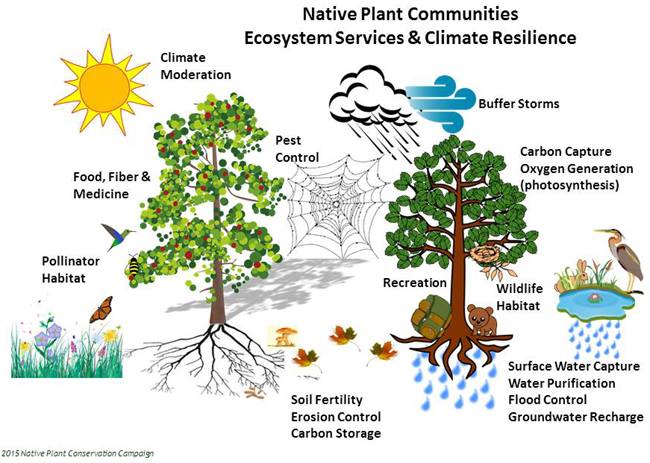
Kenya’s Greenbelt Movement has planted more than 50 million native trees to empower women, control erosion, provide food and fuel, and buffer climate change. Photo the Greenbelt Movement.
Healthy, diverse native plant communities deliver a variety of invaluable ecosystem services. The 2005 Millennium Ecosystem Assessment defined Ecosystem Services as “the benefits people derive from ecosystems (such as clean water, food, forest products, flood control, and natural resources).” Despite an estimated value of $125 trillion, these assets are not adequately accounted for in political and economic policy, which leads to insufficient investment in their protection, restoration and management.
Ecosystem Services are being adopted to address environmental problems including climate change, extreme weather, food and water insecurity, and pollution. Collectively these efforts are called Nature Based Solutions. The United Nations, World Bank, and European Union are among those promoting Nature Based Solutions to the problems facing humanity and the planet.
In January, 2020 the Nature Based Solutions Initiative at Oxford University released four principles for the development of sustainable and successful Nature Based Solutions. In brief, they state that successful Nature Based Solutions should:
- Play a vitally important role in helping us to mitigate and adapt to climate change but are not a substitute for a rapid fossil fuel phase-out and must not delay urgent action to decarbonise our economies
- Involve the protection and/or restoration of a wide range of naturally occurring ecosystems on land and in the sea. Currently, high level multilateral pledges for nature focus on forests, but other ecosystems are also rich in carbon and biodiversity and support the livelihoods of millions of people. It is essential to prevent inappropriate tree-planting on naturally open ecosystems such as grasslands, savannas, and peatlands.
- Are implemented with full engagement and consent of Indigenous Peoples and local communities, apply robust social safeguards, and are designed to build human capacity to adapt to climate change. Ecosystem protection and restoration will only yield benefits if livelihoods and human rights are recognised, respected and upheld throughout.
- Sustain, enhance or support biodiversity from the level of the gene to the level of the ecosystem. Biodiversity secures the flow of essential services, reduces trade-offs among them (e.g. between carbon storage and water supply), and builds human capacity to adapt to climate change in urban and rural areas. While commercial forestry is needed, successful NbS avoids large-scale tree-planting with single, non-native species or low diversity plantations.
Read the full statement of principles with references.
These pages provide background on ecosystem services, and nature based solutions and information on specific categories of ecosystem services:
Click to see a Prezi Presentation of the Ecosystem Services shown above.
*New Click here to see a NPCC slideshow on Ecosystem Services and Nature Based Solutions (PDF)
WATER STORAGE AND PURIFICATION
Healthy wetlands and other native plant communities slow water and absorb its energy, allowing water to percolate to soils and aquifers, rather than running off as floodwaters. Plant roots, shoots, and leaves absorb, filter and remove pollutants such as metals, viruses, bacteria, pathogens, oils, excess nutrients, and sediment so the clean water is delivered to aquifers and surface waters. Water captured and stored in plants, soils and root systems helps to secure and stabilize water supplies.
STORM PROTECTION AND FLOOD CONTROL
Healthy wetlands, forests, and other native plant communities slow surface water flows and absorb energy, protecting communities from extreme rainfall events, rising sea levels, and flooding. Coastal native plant communities such as mangrove forests and coastal marshes absorb and slow the movement of hurricanes and other strong storms. The protective effect of coastal plant communities can extend far inland.
SOIL FERTILITY AND NUTRIENT CYCLING
Life on earth depends on the continuous cycling of about 30–40 of the 90 chemical elements that occur in nature. Native vegetation’s extensive root systems and associated microorganisms digest plant and animal waste and other dead organic matter, recycling nutrients back into the ecosystem. Plants and symbiotic bacteria and fungi also partner to make atmospheric nitrogen, mineral phosphorous and other essential nutrients available to plants and animals through nitrogen fixation and other processes. Native plant communities also improve soil health and increase soil organic carbon, infiltration rates, water holding capacity and fertility compared to row crops or introduced non-native species.
PEST CONTROL AND WASTE DISPOSAL
Spiders, bats, birds, carnivorous plants and other species help to control insects and other pests. For example, according to the U.S. Fish and Wildlife Service, A typical summer colony of 100 bats feeding 200 days will consume more than 2,200 pounds of insects or approximately 600,000,000 bugs! These organisms depend on healthy native plant communities for food, shelter and other habitat.
Further, through decomposition, healthy ecosystems break down both natural and human generated waste and recycle the nutrients and other materials into growing plants and animals. Native plant communities also trap filter pollutants in wastewater, leading to cleaner and healthier and water supplies.
WILDLIFE HABITAT
Wildlife require locally adapted native plants for food, shelter, hiding cover and habitat. Wild native animals and plants have adapted to each other and to their specialized habitats over many thousands of years. Specialized relationships among specific native plant and other species are required to maintain sustainable and resilient food webs. That is why the Endangered Species Act, for example, includes designation of “critical habitat” (i.e. protection of local native plant communities) as an essential part of species conservation.
AIR QUALITY, WEATHER AND CLIMATE MODERATION
Foliage of trees and other native plants also traps and absorbs air pollutants, buffers the extremes of local weather and produce oxygen through photosynthesis, while also sequestering carbon to combat climate change. Trees and other plants also improve air quality by lowering air temperatures, reducing emissions from building energy use and other sources. The water that a single tree transpires daily has a cooling effect equivalent to two domestic air conditioners for a day.
HEALTH, WELL BEING AND MEDICINE
Medicinal plants that reside in natural areas have received increasing scientific and commercial attention. In the United States, of the top 150 prescription drugs, at least 118 are based on natural sources.
In recent years, studies have found public health benefits from native plant communities as well as native plant species. Studies have found stronger immune systems and reduced incidence of asthma for children in areas dominated by native plants compared to areas dominated by non-native plants or pavement. The 2018 Forest Service study is the first to indicate that native plant diversity can protect public health.
Ecosystem services also support health and life (e.g., by providing air, water, food, raw materials, medicines), security (e.g., by mitigating extreme weather events, spread of vector-borne diseases), and quality of life (e.g., by supporting mental and physical health, cultural identity, recreation), among many other things (Ecosystem Services Toolkit, Canada 2015).
FOOD SECURITY INCLUDING POLLINATOR HABITAT
Conserving native plant communities protects our food supply. Native plants support wild pollinators that are essential to stable and secure production of foods and other crops. Native plant communities also are reservoirs of wild relatives of crop species and the genetic diversity they contain. This diversity is essential to stable crop production in the face of climate change, invasive species, diseases and other accelerating stressors.
ECONOMIC IMPACTS: JOBS, PROPERTY VALUES
As a result of these ecosystem services, natural areas that support healthy native plant communities have measurable positive effects on local and national jobs and employment, even on local property values. For example, according to the National Park Service:
- In 2016, 331 million people visited national parks. These visitors spent an estimated $18.4 billion in local gateway communities, supported 318,100 jobs, and added $34.9 billion in economic output in the national economy.
- Every tax dollar that is invested in the National Parks Service yields a $10 return on investment.
- Consumers spend $887 billion annually on outdoor recreation, creating 7.6 million jobs.
- In rural counties with 100,000 acres of protected public lands (relative to those with none), income per person is on average higher by $4,360
General Ecosystem Services/Nature Based Solutions Resources
Nature Based Solutions for Water — United Nations World Water Report 2018
Nature Based Solutions for Climate from the United Nations Global Compact
Nature Based Solutions for Climate Manifesto – developed for the 2019 Global Climate Summit
Nature Based Solutions for cities. The NATURVATION project. 2016 – 2020 European Commission project to realize the potential of nature-based solutions for responding to urban sustainability challenges.
National Ecosystem Services Partnership Duke University
Millennium Ecosystem Assessment Linking Ecosystem Services and Human Well-Being
The Economics of Ecosystems and Biodiversity (TEEB)
International Society for Ecological Economics
Ecosystem Services for Poverty Alleviation (UK)
Completing and Using Ecosystem Service Assessment for Decision-Making: An Interdisciplinary Toolkit for Managers and Analysts Value of Nature to Canadians Study Taskforce Federal, Provincial, and Territorial Governments of Canada — 2017 Her Majesty the Queen in Right of Canada
Advantages of Native Plants Overview — from Natives First
Advantages of Native Plants Overview Infographic — from Natives First
A Community on Ecosystem Services (ACES)
Nature Based Solutions for Urban Environments — European Union
Learn more about what others are doing to promote Nature Based Solutions to climate and other threats at the:
- Oxford University Nature Based Solutions Initiative
- European Commission
- International Union for the Conservation of Nature
- Nature Based Solutions to disasters
- The World Bank (released a call to action on April 10, 2019)



